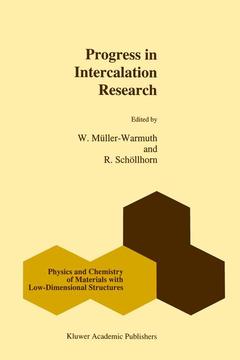Progress in Intercalation Research, 1994 Physics and Chemistry of Materials with Low-Dimensional Structures Series, Vol. 17
Langue : Anglais
Coordonnateurs : Müller-Warmuth W., Schöllhorn R.

The combination of solid materials of different structural dimensionality with atomic or molecular guest species via intercalation processes represents a unique and widely variable low temperature synthesis strategy for the design of solids with particular composition, structure and physical properties. In the last decade this field has experienced a rapid development and represents now an established specific domain of solid state research and materials science. Substantial progress has been made with respect to an understanding of the complex relationship between structure, bonding, physical properties and chemical reactivity since the first volume on the subject appeared in this series in 1979 (Intercalated Layered Materials, F. Levy, ed.). The purpose of this volume is to present a survey on progress and per spectives based on the treatment of a series of major areas of activities in this field. By the very nature of its subject this monograph has an interdisciplinary character and addresses itself to chemists, physicists and materials scien tists interested in intercalation research and related aspects such as design and characterization of complex materials, low temperature synthesis, solid state reaction mechanisms, electronic/ionic conductivity, control of electronic properties of solids with different structural dimensionality and application of intercalation systems. Several chapters have been devoted to specific groups of host lattices.
Materials and Models: Faces of Intercalation Chemistry.- 1. Introduction.- 2. Concepts and Categories.- 3. Materials.- 4. Models.- 5. Conclusions.- References.- Graphite — A Unique Host Lattice.- 1. Introduction.- 2. Preparation of Graphite Intercalation Compounds.- 3. Structural Organization.- 4. Chemical Bonding.- 5. Chemical Reactivity.- 6. Epilogue.- Acknowledgements.- References.- Electronic Properties and Reactivity.- 1. Introduction.- 2. About the Electronic Structures of Transition Metal Chalcogenides.- 3. Electronic Transfer and Reactivity.- 4. Electronic Transfer and Phase Transitions.- 5. Order and Disorder versus Electronic Structure.- 6. Conclusion.- References.- Intercalation Chemistry of Selected Layered Oxides and Phosphates.- 1. Introduction.- 2. Layered Ternary Oxides.- 3. Layered Perovskites.- 4. Silicic Acids.- 5. Group 4 and 14 Metal Phosphates.- 6. Pillaring of Layered Compounds.- 7. Layered Metal Phosphonates.- 8. Miscellany of Topics.- 9. Conclusion.- Acknowledgements.- References.- Intercalation Processes in Redox Conducting Polymers.- 1. Introduction.- 2. Synthesis, Morphology and Structure of Undoped Polymers.- 3. Intercalation Methods.- 4. Intercalation Mechanisms - Nature of the Intercalated Species.- 5. Structural Evolution of Conducting Polymers upon Intercalation.- 6. Polymers with Ion Exchange Properties.- 7. Conclusion.- Acknowledgements.- References.- Structure, Bonding, Dynamics: NMR Studies.- 1. Introduction.- 2. General Aspects of NMR Spectroscopy and Its Application to Intercalation Compounds.- 3. Hydrated Layered Chalcogenides.- 4. Layered Chalcogenides with Intercalated Ammonia, Metal-Ammonia and Amines.- 5. Intercalation of Further Atomic and Molecular Species in Layered Materials.- 6. Graphite Intercalation Compounds.- 7.Hydrogen Bronzes.- 8. Intercalation Compounds of Host Lattices with Framework Structure.- Acknowledgements.- References.- Applications: From Battery Materials to Sensor Systems.- 1. Scope.- 2. Introduction.- 3. Intercalation Electrodes in Electrochemical Power Sources.- 4. Intercalation Compounds in Electrochromic Devices.- 5. Intercalation Chemistry and Chemical Sensors.- 6. Miscellaneous Applications of Intercalation Compounds.- References.
Date de parution : 10-2012
Ouvrage de 514 p.
16x24 cm
Thème de Progress in Intercalation Research :
Mots-clés :
chemistry; dynamics; nuclear magnetic resonance (NMR); polymer; polymers
© 2024 LAVOISIER S.A.S.
